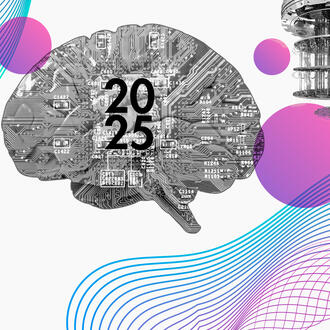Credit: mouu007 / Shutterstock
What you’ll learn:
- Organizations that are AI mature outperform early-stage AI implementers — but many companies struggle to advance from AI pilots to AI at scale.
- New research suggests that companies can advance in AI maturity by focusing on four factors: aligning AI investments with strategic goals; building modular platforms and data systems; synchronizing efforts to create AI-ready people, roles, and teams; and practicing good stewardship by creating transparent and compliant AI practices.
Companies are making significant gains in their AI maturity, with the greatest financial impact seen in the progression from building pilots and capabilities to scaling ways of working with AI, according to a new research briefing from the MIT Center for Information Systems Research.
Last year, MIT CISR researchers introduced a four-stage enterprise AI maturity framework to help leaders create value from AI. They found that the financial performance of enterprises in the first two stages of AI maturity was below the industry average, while enterprises in stages 3 and 4 had financial performance well above the industry average.
An update by CISR researchers and Evgeny Káganer found that organizations see the greatest financial impact in moving from Stage 2 to Stage 3 of AI maturity. In Stage 2, enterprises establish AI capabilities such as business case development and testing, process simplification and automation, and employee experimentation. In Stage 3, enterprises build on these capabilities to scale AI across the business and embed AI use.
Four challenges in moving from AI pilots to scaling
Based on interviews with senior executives about their AI initiatives, the researchers identified four challenges that enterprises need to address to move from Stage 2 to Stage 3 of enterprise AI maturity.
- Strategy: Align AI investments with strategic goals, and offer measurable, scalable value.
- Systems: Architect modular, interoperable platforms and data ecosystems to enable enterprisewide intelligence.
- Synchronization: Create AI-ready people, roles, and teams while redesigning work around AI capabilities.
- Stewardship: Embed and monitor compliant, human-centered, and transparent AI practices by design.
Two case studies in advancing AI maturity
The researchers highlighted two case studies that demonstrate how companies are navigating these four challenges as they move their enterprises from Stage 2 to Stage 3 of enterprise AI maturity.
Guardian: Using AI to deepen customer engagement and automate processes
Guardian Life Insurance is using AI in three areas: improving the customer experience, driving efficiency and a reduction in operating expenses, and improving employee productivity.
- Strategy: Guardian’s data and AI team owns AI strategy and prioritization. A value-tracking framework guides initiatives from hypothesis to pilot to scale, keeping efforts tied to measurable impact. One pilot — automating the RFP and quoting process — cut its turnaround time from about a week to 24 hours. Guardian plans to scale the project in 2026.
- Systems: To support scaling, Guardian modernized legacy systems and data architecture. The CTO reorganized around products and platforms with small cross-functional teams, microservices, and APIs enabling reuse and faster delivery.
- Synchronization: Guardian is reskilling its workforce by reorganizing employees into AI-focused roles and emphasizing solving end-to-end business problems. Longer-term plans include rotations and training programs to build people’s hybrid business-technical skills.
- Stewardship: Given its regulated environment, Guardian embedded governance with risk, legal, and compliance teams. Architecture reviews happen via both formal and fast-track boards, which ensures that privacy, security, and regulatory requirements are built into new solutions.
Italgas: Using AI to monitor infrastructure in real time
Europe’s largest natural gas distributor is embedding AI to manage infrastructure, boost efficiency, and improve safety. Digital Factory, its innovation hub, anchors this effort, supported by executive sponsorship and cross-functional teams.
- Strategy: Italgas is prioritizing AI projects like WorkOnSite, which has accelerated construction projects by 40% and reduced inspections by 80%, and DANA, a generative AI-based network control system. Each minimum viable product sprint is backed by a C-level sponsor to ensure strategic alignment.
- Systems: Italgas has digitized its assets and processes since 2017, building a cloud-based platform with an Internet of Things infrastructure, a 300-terabyte data platform, and 23 AI models. Business translators embedded in units drive adoption and application of modular components.
- Synchronization: The enterprise has engaged more than 1,000 employees in innovation initiatives and delivered 30,000 hours of AI/data training in 2024. Supported by Italgas Academy, employees are mapped to a new digital leadership model, building an agile, AI-ready workforce while maintaining continuity.
- Stewardship: Governance structures include a chief people, innovation, and transformation officer and an AI officer and a group AI office that oversee AI integration and monitoring. Initiatives balance efficiency gains with new business opportunities, such as commercializing WorkOnSite, an effort that generated 3 million euros in revenue in 2024.
AI maturity represents major organizational change
The researchers emphasize that transitioning through stages of AI maturity represents a major organizational change and that businesses will likely have to overcome both human resistance and technological complexity. Driving change requires a united front among the CEO, CIO, chief strategy officer, and the head of human resources.
“Now is the time for executive teams to align, commit, and lead the charge toward enterprise-scale AI by developing a playbook for strategy, systems, synchronization, and stewardship,” the researchers write.
This article is based on research by Stephanie Woerner, Peter Weill, Ina Sebastian, and Evgeny Káganer. Stephanie Woerner is a principal research scientist at MIT Sloan and the director of MIT CISR. She studies how companies use technology and data to make more effective business models, as well as how they manage associated organizational change, governance, and strategy implications. Peter Weill is a senior research scientist at MIT Sloan and chairman at MIT CISR. His work explores future trends, such as digital business models, IT investment portfolios, and AI maturity models, to help organizations maintain a competitive edge. Ina Sebastian is a research scientist at MIT CISR. She studies how large enterprises transform for success in the digital economy, with a focus on digital partnering, value creation, and value capture in digital models. Evgeny Káganer is a professor at IESE Business School and a research collaborator at MIT CISR. His research explores how digitalization and AI reshape business models and organizations.



